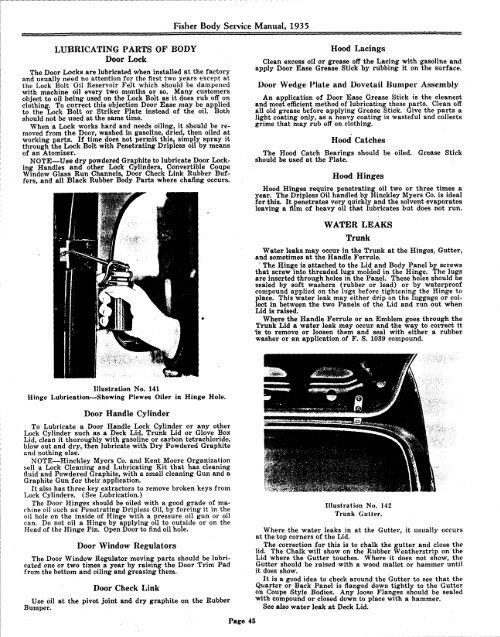1935 Cadillac - GM Heritage Center
1935 Cadillac - GM Heritage Center
1935 Cadillac - GM Heritage Center
You also want an ePaper? Increase the reach of your titles
YUMPU automatically turns print PDFs into web optimized ePapers that Google loves.
Fisher Body Service Manual, <strong>1935</strong><br />
LUBRICATING PARTS OF BODY<br />
Door Lock<br />
The Door Locks are lubricated when installed at the factory<br />
and usually need no attention for the first two years except at<br />
the Lock Bolt Oil Reservoir Felt which should be dampened<br />
with machine oil every two months or so. Many customers<br />
object to oil being used on the Lock Bolt as it does rub off on<br />
clothing. To correct this objection Door Ease may be applied<br />
to the Lock Bolt or Striker Plate instead of the oil. Both<br />
should not be used at the same time.<br />
When a Lock works hard and needs oiling, it should be removed<br />
from the Door, washed in gasoline, dried, then oiled at<br />
working parts. If time does not permit this, simply spray it<br />
through the Lock Bolt with Penetrating Dripless oil by means<br />
of an Atomizer.<br />
NOTE—Use dry powdered Graphite to lubricate Door Locking<br />
Handles and other Lock Cylinders, Convertible Coupe<br />
Window Glass Run Channels, Door Check Link Rubber Buffers,<br />
and all Black Rubber Body Parts where chafing occurs.<br />
Hood Lacings<br />
Clean excess oil or grease off the Lacing with gasoline and<br />
apply Door Ease Grease Stick by rubbing it on the surface.<br />
Door Wedge Plate and Dovetail Bumper Assembly<br />
An application of Door Ease Grease Stick is the cleanest<br />
and most efficient method of lubricating these parts. Clean off<br />
all old grease before applying Grease Stick. Give the parts a<br />
light coating only, as a heavy coating is wasteful and collects<br />
grime that may rub off on clothing.<br />
Hood Catches<br />
The Hood Catch Bearings should be oiled. Grease Stick<br />
should be used at the Plate.<br />
Hood Hinges<br />
Hood Hinges require penetrating oil two or three times a<br />
year. The Dripless Oil handled by Hinckley Myers Co. is ideal<br />
for this. It penetrates very quickly and the solvent evaporates<br />
leaving a film of heavy oil that lubricates but does not run.<br />
WATER<br />
Trunk<br />
LEAKS<br />
Water leaks may occur in the Trunk at the Hinges, Gutter,<br />
and sometimes at the Handle Ferrule.<br />
' The Hinge is attached to the Lid and Body Panel by screws<br />
that screw into threaded lugs molded in the Hinge. The lugs<br />
are inserted through holes in the Panel. These holes should be<br />
sealed by soft washers (rubber or lead) or by waterproof<br />
compound applied on the lugs before tightening the Hinge to<br />
place. This water leak may either drip on the luggage or collect<br />
in between the two Panels of the Lid and run out when<br />
Lid is raised.<br />
Where the Handle Ferrule or an Emblem goes through the<br />
Trunk Lid a water leak may occur- and the way to correct it<br />
is to remove or loosen them and seal with either a rubber<br />
washer or an application of F. S. 1039 compound.<br />
Illustration No. 141<br />
Hinge Lubrication—Showing Plewes Oiler in Hinge Hole.<br />
Door Handle Cylinder<br />
To Lubricate a Door Handle Lock Cylinder or any other<br />
Lock Cylinder such as a Deck Lid, Trunk Lid or Glove Box<br />
Lid, clean it thoroughly with gasoline or carbon tetrachloride,<br />
blow out and dry, then lubricate with Dry Powdered Graphite<br />
and nothing else.<br />
NOTE—Hinckley Myers Co. and Kent Moore Organization<br />
sell a Lock Cleaning and Lubricating Kit that has cleaning<br />
fluid and Powdered Graphite, with a small cleaning Gun and a<br />
Graphite Gun for their application.<br />
It also has three key extractors to remove broken keys from<br />
Lock Cylinders. (See Lubrication.)<br />
The Door Hinges should be oiled with a good grade of machine<br />
oil such as Penetrating Dripless Oil, by forcing it in the<br />
oil hole on the inside of Hinge with a pressure oil gun or oil<br />
can. Do not oil a Hinge by applying oil to outside or on the<br />
Head of the Hinge Pin. Open Door to find oil hole.<br />
Door Window Regulators<br />
The Door Window Regulator moving parts should be lubricated<br />
one or two times a year by raising the Door Trim Pad<br />
from the bottom and oiling and greasing them.<br />
Door Check Link<br />
Use oil at the pivot joint and dry graphite on the Rubber<br />
Bumper.<br />
Illustration No. 142<br />
Trunk Gutter.<br />
Where the water leaks in at the Gutter, it usually occurs<br />
at the top corners of the Lid.<br />
The correction for this is to chalk the gutter and close the<br />
lid. The Chalk will show on the Rubber Weatherstrip on the<br />
Lid where the Gutter touches. Where it does not show, the<br />
Gutter should be raised with a wood mallet or hammer until<br />
it does show.<br />
It is a good idea to check around the Gutter to see that the<br />
Quarter or Back Panel is flanged down tightly to the Gutter<br />
on Coupe Style Bodies. Any loose Flanges should be sealed<br />
with compound or closed down to place with a hammer.<br />
See also water leak at Deck Lid.<br />
Page 45
















